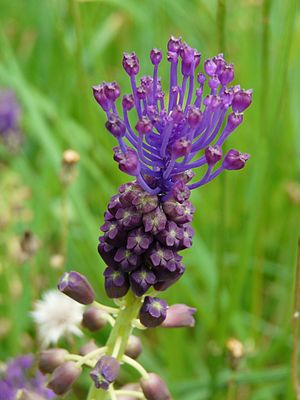Muscari comosum: Difference between revisions
From LSJ
Αὐρήλιοι... πατρὶ... καὶ μητρὶ... μνήμης χάριν → The Aurelii, in memory of their father and mother (inscription from Aizonai, Phrygia)
(latin463) |
mNo edit summary |
||
| Line 1: | Line 1: | ||
{{lael | {{lael | ||
|lgtx=[[ἀγριοκρόμμυον]] | |lgtx=[[ἀγριοκρόμμυον]], [[βολβός]] | ||
}} | |||
{{wkpen | |||
|wketx=[[File:Muscari comosum 08-05-2010 (1).JPG|thumb|Muscari comosum]] [[Leopoldia comosa]] (syn. [[Muscari comosum]]) is a perennial bulbous flowering plant in the family Asparagaceae. Usually called the tassel hyacinth or tassel grape hyacinth, it is one of a number of species and genera also known as grape hyacinths. It is found in rocky ground and cultivated areas, such as cornfields and vineyards in the Mediterranean region, but has naturalized elsewhere. In southern Italy and Greece, its bulb is a culinary delicacy. | |||
}} | }} | ||
Revision as of 22:58, 12 November 2024
Latin > Greek
Wikipedia EN
Leopoldia comosa (syn. Muscari comosum) is a perennial bulbous flowering plant in the family Asparagaceae. Usually called the tassel hyacinth or tassel grape hyacinth, it is one of a number of species and genera also known as grape hyacinths. It is found in rocky ground and cultivated areas, such as cornfields and vineyards in the Mediterranean region, but has naturalized elsewhere. In southern Italy and Greece, its bulb is a culinary delicacy.

